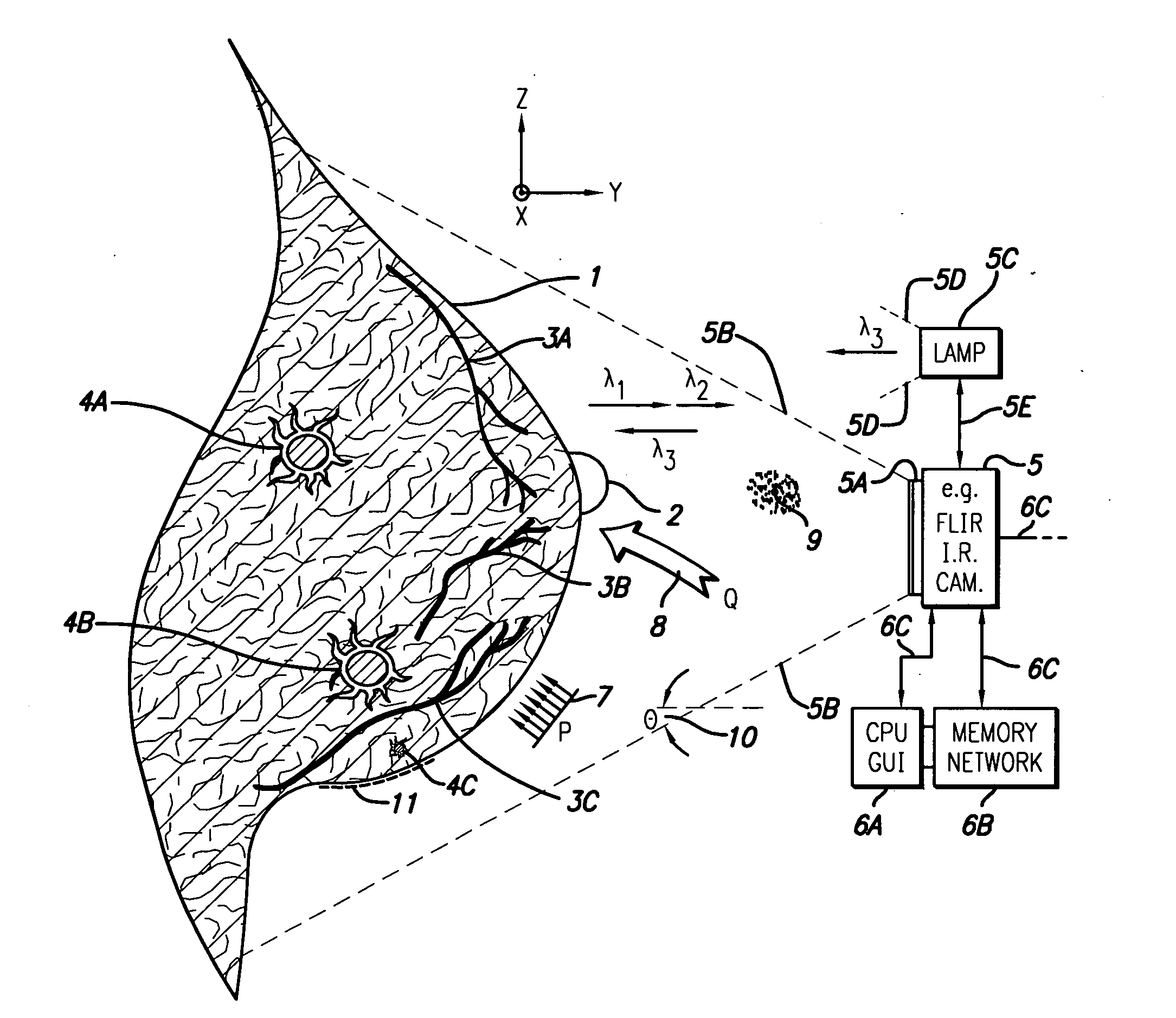Infrared detection of cancerous tumors and other subsurface anomalies in the human breast and in other body parts
- Summary
- Abstract
- Description
- Claims
- Application Information
AI Technical Summary
Benefits of technology
Problems solved by technology
Method used
Image
Examples
first main embodiment
[0063] The first embodiment of the invention utilizes a first nonpenetrating or MIR wavelength to image surface temperatures and a second penetrating wavelength or NIR to image subsurface features. The penetrating or NIR image information is employed in various ways to enhance a determination as to what is diseased and what is not relative to the purely thermographic prior art determination.
[0064] Some ways in which NIR or penetrating wavelength data can do this include the following: [0065] a) using passive or excited near-IR or NIR, delineate the outlines of sub-surface features themselves from at least one point of view and more preferably from two or more points of view, such as of vasculature and / or tumors, without the confounding thermal blooming and masking effects of the mid-IR; [0066] b) using passive or excited near-IR-, delineate any one or more of the size, shape, volume or depth of features themselves from at least one point of view and more preferably from two or more...
second main embodiment
[0077] The second embodiment is essentially the use of a preferably IR (MIR and / or NIR) transmissive or transparent window that can be IR-imaged through while it is also utilized to distort, shear or compress the breast. The preference is to have the window be IR transparent such that IR imaging can be performed while the tissue is distorted. However, within our inventive scope is the use of a plate / window, which is used to distort or compress the breast and is then removed for IR or other imaging without the plate present in the line-of-sight. As described earlier, the window may be flat, curved, rigid or flexible. It may be applied and / or held on the tissue by the clinician's hand, the patient's hand, by straps, clamps or actuator arms, or by suction or adhesive.
[0078] IR transmissive windows, particularly MIR-transparent windows, have been widely used in industrial applications for safety reasons, usually to isolate a worker from high voltages but to still allow MIR visualizatio...
third main embodiment
[0115] Moving now to FIGS. 3A-3B, we will describe the use of the second (deforming) plate / window embodiment and the third (heat-manipulating) plate / window embodiment of the invention. The plate / window is a means to thermally and / or physically manipulate tissues while preferably being able to simultaneously observe them at one or more optical wavelengths. The second and third embodiments are not limited to using a penetrating and a non-penetrating wavelength in combination like the first embodiment. Embodiments 2 and 3 may use only one wavelength or may use two or more wavelengths. Embodiments 2 and 3 preferably utilize two or more different states of tissue-deformation and / or tissue-temperature in combination with one (or more) viewing or detection wavelengths.
[0116] A rigid or semi-rigid optical window having a significant thermal capacity, such as our example window materials, can be used to deform tissue and / or inject / remove heat from tissues into or from the window's own therm...
PUM
 Login to View More
Login to View More Abstract
Description
Claims
Application Information
 Login to View More
Login to View More - R&D
- Intellectual Property
- Life Sciences
- Materials
- Tech Scout
- Unparalleled Data Quality
- Higher Quality Content
- 60% Fewer Hallucinations
Browse by: Latest US Patents, China's latest patents, Technical Efficacy Thesaurus, Application Domain, Technology Topic, Popular Technical Reports.
© 2025 PatSnap. All rights reserved.Legal|Privacy policy|Modern Slavery Act Transparency Statement|Sitemap|About US| Contact US: help@patsnap.com



